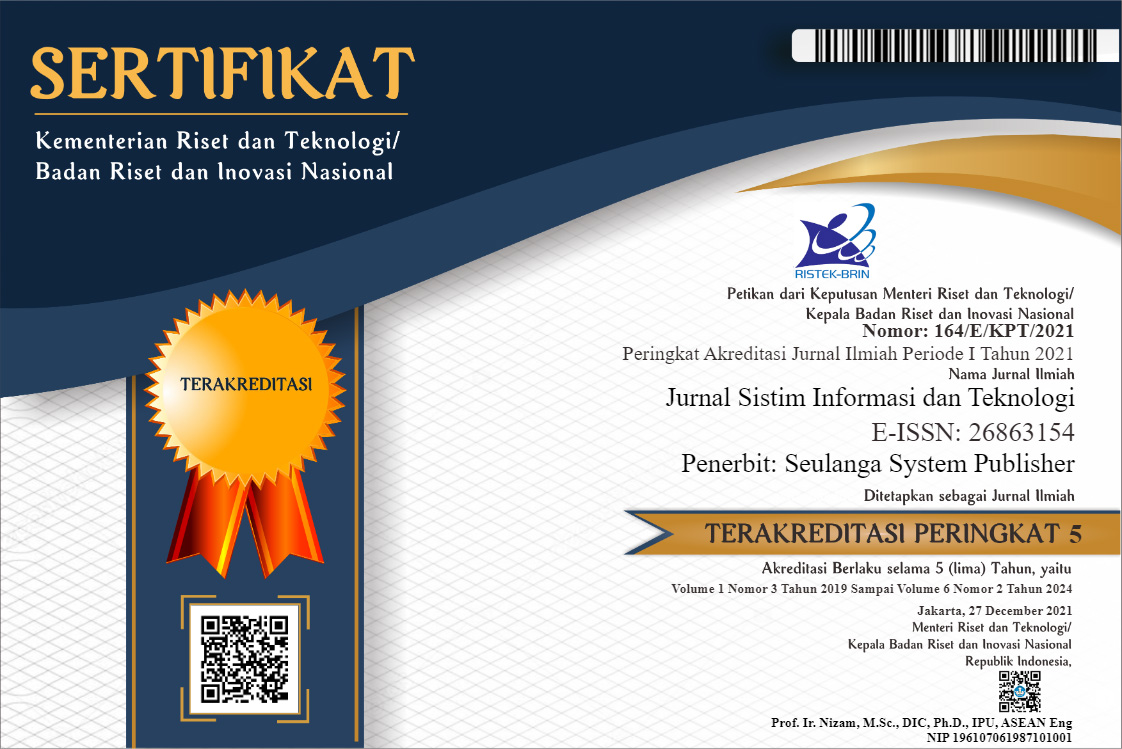Author Guidelines
The author should register as an Author and be offered as Reviewer through the following address: https://jsisfotek.org/index.php/JSisfotek/user/register. The author should fulfill the form as detailed as possible, where the star-marked state must be entered. After filling out all form textboxes, the Author clicked the “Register” button to proceed with the registration. Therefore, the Author is brought to the online author submission interface, where the Author should click “New Submission.” In the Start, a New Submission section, click “’ Click Here’: to go to step one of the four-step submission processes.” The following are four steps in the online submission process:
- Step 1 - Starting the Submission: The author must check marks on the submission checklists. An author should type or copy-paste the cover letter to “Comments for the Editor.”
- Step 2 – Uploading the Submission: To upload a manuscript to this journal, click Browse on the Upload submission file item and choose the manuscript document file (.doc/.docx) to be submitted, then click the "Upload" button until the file has been uploaded.
- Step 3 – Entering Submission’s Metadata: Detailed authors' metadata should be entered, including the marked corresponding author. After that, the manuscript title and abstract must be uploaded by copying the text and paste in the textbox, including keywords.
- Step 4 – Confirming the Submission: The author should final check the uploaded manuscript documents in this step. To submit the manuscript to JSISFOTEK journal, click the Finish Submission button after the documents are valid. The corresponding author or the principal contact will receive an acknowledgment by email and will be able to view the submission’s progress through the editorial process by logging in to the journal web address site.
After this submission, the Authors who submit the manuscript will get a confirmation email about the request. Therefore, Authors can track their submission status at any time by logging in to the online submission interface. The submission tracking includes the quality of the manuscript review and editorial process.
Article structure
Subdivision - numbered sections
Divide your article into clearly defined and numbered sections. Subsections should be numbered 1.1 (then 1.1.1, 1.1.2, ...), 1.2, etc. (the abstract is not included in section numbering). Use this numbering also for internal cross-referencing: do not just refer to 'the text.' Any subsection may be given a brief heading. Each heading should appear on its separate line.
Introduction
State the objectives of the work and provide an adequate background, avoiding a detailed literature survey or a summary of the results.
Research Method
Provide sufficient details to allow the work to be reproduced by an independent researcher. Methods already published should be summarized and indicated by a reference. If quoting directly from a previously published way, use quotation marks and cite the source. Any modifications to existing methods should also be described.
Result and Discussion
Results should be clear and concise.
Discussion should explore the significance of the results of the work, not repeat them. A combined Results and Discussion section is often appropriate. Avoid extensive citations and discussion of published literature.
Conclusions
The study's main conclusions may be presented in a short Conclusions section, which may stand alone or form a subsection of a Discussion or Results and Discussion section.
Abstract
A concise and factual abstract is required. The abstract should briefly state the research's purpose, principal results, and significant conclusions. An abstract is often presented separately from the article, so it must be able to stand alone. For this reason, References should be avoided, but if essential, cite the author(s) and year(s). Also, non-standard or uncommon abbreviations should be avoided, but if necessary, they must be defined at first mention in the abstract.
Keywords
Immediately after the abstract, provide a maximum of 5 keywords and avoid general and plural terms and multiple concepts (avoid, for example, 'and,' 'of'). Be sparing with abbreviations: only abbreviations firmly established in the field may be eligible. These keywords will be used for indexing purposes.
Acknowledgments
Mention the names of donors and helpers.
Math formulae
Please submit math equations as editable text and not as images. Present simple formulae in line with standard text where possible and use the solidus (/) instead of a horizontal line for small fractional terms, e.g., X/Y. In principle, variables are to be presented in italics. Powers of e are often more conveniently denoted by exp. Number consecutively any equations that must be displayed separately from the text (if referred to explicitly in the text).
Figure
Ensure that each illustration has a caption. Supply captions separately, not attached to the figure. A caption should comprise a brief title (not on the figure itself) and a description of the illustration. Keep text in the illustrations themselves to a minimum but explain all symbols and abbreviations used.
Tables
Please submit tables as editable text and not as images. Tables can be placed either next to the relevant text in the article or on separate pages (s) at the end. Number tables consecutively following their appearance in the text and place any table notes below the table body. Be sparing in using tables and ensure that the data presented in them do not duplicate results described elsewhere in the article. Please avoid using vertical rules and shading in table cells.
References
Citation in text
Please ensure that every reference cited in the text is also in the reference list (and vice versa). Any references cited in the abstract must be given in full. Unpublished results and personal communications are not recommended in the reference list but may be mentioned in the text. If these references are included in the reference list, they should follow the standard reference style of the journal and should have a substitution of the publication date with either 'Unpublished results' or 'Personal communication.' The citation of a reference as 'in press' implies that the item has been accepted for publication.
Web references
At a minimum, the full URL and the date when the reference was last accessed should be given. Any further information should also be provided if known (DOI, author names, dates, reference to a source publication, etc.). Web references can be listed separately (e.g., after the reference list) under a different heading if desired or can be included in the reference list.
Data references
This journal encourages you to cite underlying or relevant datasets in your manuscript by citing them in your text and including a data reference in your Reference List. Data references should include the following elements: author name(s), year, dataset title, data repository, version (where available), and global persistent identifier. Add [dataset] immediately before the reference to correctly identify it as a data reference. The [dataset] identifier will not appear in your published article.
Reference style
This is using IEEE Style.
Manuscript Template Guide
Please review our Manuscript Template (Download) to use as a guide (copy the link address and paste it into a new tab).









